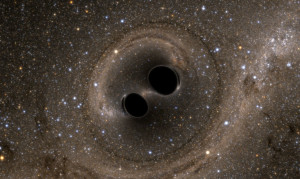
In September 14, 2015, two observatories detected gravitational waves, confirming a prediction made by Albert Einstein’s general theory of relativity in 1915.
The waves were produced when two black holes merged to produce a single, massive black hole about 1.3 billion years ago.
Scientists estimate the black holes were about 29 and 36 times the mass of the sun. About 3 times the mass of the sun was converted into gravitational waves in a fraction of a second—with a peak power output about 50 times that of the whole visible universe.
By looking at the time of arrival of the signals—the detector in Livingston, Louisiana, recorded the event 7 milliseconds before the detector in Hanford, Washington—scientists can say that the source was located in the Southern Hemisphere.
According to general relativity, a pair of black holes orbiting around each other lose energy through the emission of gravitational waves, causing them to gradually approach each other over billions of years, and then much more quickly in the final minutes.
During the final fraction of a second, the two black holes collide into each other at nearly one-half the speed of light and form a single more massive black hole, converting a portion of the combined black holes’ mass to energy, according to Einstein’s formula E=mc2. This energy is emitted as a final strong burst of gravitational waves. It is these gravitational waves that Laser Interferometer Gravitational-wave Observatory (LIGO) detectors observed.
The existence of gravitational waves was first demonstrated in the 1970s and 80s by Joseph Taylor, Jr., and colleagues. Taylor and Russell Hulse discovered in 1974 a binary system composed of a pulsar in orbit around a neutron star. Taylor and Joel M. Weisberg in 1982 found that the orbit of the pulsar was slowly shrinking over time because of the release of energy in the form of gravitational waves. For discovering the pulsar and showing that it would make possible this particular gravitational wave measurement, Hulse and Taylor were awarded the Nobel Prize in Physics in 1993.
A TEAM OF MORE THAN 1,000 SCIENTISTS
The new LIGO discovery is the first observation of gravitational waves themselves, made by measuring the tiny disturbances the waves make to space and time as they pass through the earth.
“Our observation of gravitational waves accomplishes an ambitious goal set out over 5 decades ago to directly detect this elusive phenomenon and better understand the universe, and, fittingly, fulfills Einstein’s legacy on the 100th anniversary of his general theory of relativity,” says Caltech’s David H. Reitze, executive director of the LIGO Laboratory.
The discovery was made possible by the enhanced capabilities of Advanced LIGO, a major upgrade that increases the sensitivity of the instruments compared to the first generation LIGO detectors, enabling a large increase in the volume of the universe probed—and the discovery of gravitational waves during its first observation run.
The US National Science Foundation leads in financial support for Advanced LIGO. Funding organizations in Germany (Max Planck Society), the UK (Science and Technology Facilities Council, STFC), and Australia (Australian Research Council) also have made significant commitments to the project.
LIGO research is carried out by the LIGO Scientific Collaboration (LSC), a group of more than 1000 scientists from universities around the United States and in 14 other countries. More than 90 universities and research institutes in the LSC develop detector technology and analyze data; approximately 250 students are strong contributing members of the collaboration.
“This detection is the beginning of a new era: The field of gravitational wave astronomy is now a reality,” says Gabriela González, LSC spokesperson and professor of physics and astronomy at Louisiana State University.
LIGO was originally proposed as a means of detecting these gravitational waves in the 1980s by Rainer Weiss, professor of physics, emeritus, from MIT; Kip Thorne, a professor of theoretical physics, emeritus, from Caltech; and Ronald Drever, professor of physics, emeritus, also from Caltech.
“The description of this observation is beautifully described in the Einstein theory of general relativity formulated 100 years ago and comprises the first test of the theory in strong gravitation. It would have been wonderful to watch Einstein’s face had we been able to tell him,” says Weiss.
“With this discovery, we humans are embarking on a marvelous new quest: the quest to explore the warped side of the universe—objects and phenomena that are made from warped spacetime. Colliding black holes and gravitational waves are our first beautiful examples,” says Thorne.
The team describes the discovery in a paper published in the journalPhysical Review Letters.
Source: Caltech and Futurity.org





Recording and analyzing gravitational waves seems like a marvelous new method for learning about the universe. However, for this method to be as useful as photon astronomy, there will have to be methods to 1) learn the direction of the emitting object, and 2) learn its distance from us.